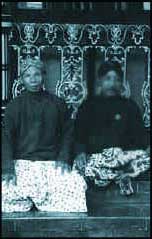 |
Jogjakarta
Geographically, the Province of Yogyakarta -- one of the three Special Regions of Indonesia (the others being the capital city of Jakarta and Aceh in the northern tip of Sumatra) -- is situated in the southern part of Central Java and is one of the foremost cultural centres of Java. Administratively, Yogyakarta is surrounded by four regencies of Central Java: - Wonogiri Regency, - Klaten Regency, - Magelan Regency, - and Purworejo Regency. On the south Yogyakarta is bordered by the Indian Ocean, stretching about 100 km from west to east, starting with Congot beach in the west and ended with Sadeng beach in the east. The Province of Yogyakarta -- with a total land area of 3,185.80 sq. km -- consists of four regencies and one munipality: - Yogyakarta Munipality : 32.50 sq. km. - Sleman Regency : 574.82 sq. km. - Bantul Regency : 506.86 sq. km. - Kulonprogo Regency : 586.27 sq. km. - Gunungkidul Regency : 1,486.36 sq. km. Located at the foot of the 2,914 meter high active volcano Gunung Merapi (Mountain of Fire), the fertile plain of Yogyakarta was in the 16th and 17th centuries the seat of the mighty Javanese empire of Mataram, Ngayogyakarto Hadiningrat, from which present-day Yogyakarta has inherited the best of traditions. The city itself has a special gentle charm which seldoms fails to captivate the visitor. A sultanate still under the jurisdiction of Sultan Hamengku Buwono X and now one of the most densely populated areas of Indonesia (more than 1000 persons per sq. km.), Yogyakarta came into being in 1755 when the Dutch, by then firmly in control of Java though allowing the continued existence of Javanese sultanates, lost patience over the continues Rebellions.Splitting the much weakened sultanate of Mataram into the two smaller "self-ruling" territories of Surakarta and Yogyakarta, the Dutch appointed Prince Mangkubumi, the first Sultan of Yogyakarta, who ascended the throne of the new sultanate as Hamengku Buwono I. Within the city limits, the Sultan`s Palace or Kraton and the Water Castle ruins are now a major tourist`s attraction of the area. Whitin easy reach from the many first rate hotels in Yogyakarta are the old temple ruins of Prambanan and the restored Borobudur Buddhist sanctuary. Gamelan, classical and contemporary Javanese dances, the wayang kulit (leather puppet) theatre and other forms of traditional art will amaze the visitor. Yogya`s craftsmen excell in the art of batik, silver and leather work and delight in showing off their skill to the visitor. In the silver workshops of Kotagede, once the seat of the Mataram empire, but now a tranquil little town just a few kilometre east of Yogyakarta, there hardly seem to exist any trade secrets: every body is welcome to watch as the silver is being transformed from raw material into beautiful works of art under the deft hands of the numerous craftsmen. The Sultan`s Palace is the hub of Yogyakarta`s traditional life. Despite the advance of modernity, it still reflexes the spirit of refinement which has been the hallmark of Yogya`s art for centuries. Since its beginning in 1755, the Kraton has received many a royal guest and served as a stage for exclusive court dances. Today, it is treasured as an archetype of classical Javanese architecture, the ornate carvings and gilded beams testifying its royal origin. Next to the traditional, the contemporary arts are finding fertile soil in Yogyakarta`s culture-oriented society. ASRI , the College of Fine Arts, is the academic centre of these arts and Yogyakarta itself has given its name to an important school of modern painting in Indonesia, perhaps best personified by the famed Indonesian impressionist, Affandi. There are many others, and another place where so much can be found in so small an area (3,169 sq. km) is probably hard to find. Roads leading to the main places of interest are good and local transportation easy to obtain. Buses play predetermined route regularly within the city and from points in the city to destinations outside. So do the so called "colts" - small taxis - usually of Japanese make. Taxis are available at the airport and at the better hotel counters. But Yogya`s atmosphere invites casualnes and leisure and it is completely in style to ride a "becak" (tricycle) or "andong" fourwheeled horse-cart whenever one wants to go on his own on a modest budget. |